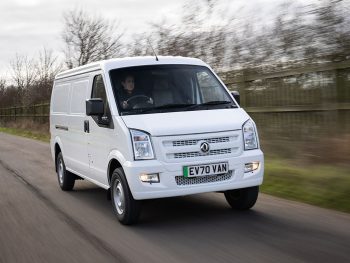John Kendall tries out a van that offers battery power on a budget.

You don’t need to be told how much petrol and diesel prices have risen so far this year, with the economy heading for recession and inflation like we haven’t seen for 40 years. Even with rising electricity prices there are still many good reasons to think seriously about electric vans, if you can find one to buy.
One of the arguments against has been the cost of buying or leasing an electric van, so finding one with an on-the-road price of £20,999 is potentially appealing. It’s from DFSK, a Chinese brand that has been on sale here previously, now with a new importer, Innovation Automotive. The van itself, the EC35, is new to the UK market. It’s of a size that doesn’t readily fit into our usual van categories. Although it’s relatively compact, it offers a payload that is competitive with vans such as the Citroën ë-Berlingo/Peugeot e-Partner and their Stellantis stablemates, the Vauxhall Combo-e, new Fiat Doblo as well as Toyota Proace City electric. That is the principal competition until the new Renault Kangoo and Mercedes-Benz Citan electric models arrive, as well as the electric variant of the Ford Transit Connect and the Volkswagen ID. Buzz Cargo.
The hydrogen fuel cell has been under development for many years by vehicle manufacturers – it’s one of those technologies that has seemed to be permanently 20 years away. I first saw a hydrogen fuel-cell prototype van – a Mercedes-Benz MB100 in the mid 1990s. The fuel cell took up the entire load space of the van at the time. I drove a hydrogen fuel cell-powered vehicle for the first time around 20 years ago.
Compared with its rivals, it’s a matter of, “You get what you pay for”. You won’t find a button to boost regenerative braking – that’s triggered when you press the brake pedal. There are no tie-down eyes in the load area. It is noisy compared with its rivals, particularly at low speeds when the automatic low-speed EV warning sound is generated. The noise echoes around the van and only starts to fade after 20mph, finally disappearing as you approach 30mph. If you drive in town traffic all day, it could get a bit wearing. The steering column stalks hark back to some older Japanese and Korean models, with indicators on the right and wipers on the left. Storage space in the cabin is a bit limited. There are narrow door pockets, a glovebox and little else besides. There are two good cup holders though.
Its quirks include a rev counter – a hangover from the petrol engine model that works, but doesn’t mean anything. There’s a left footrest in the passenger footwell, but not on the driver’s side. On the plus side, there’s a touchscreen Grundig audio system, which includes Android Auto and Apple CarPlay, with the connector in the glovebox.

Taking the plunge on an EC35 all depends on what you intend to use the van for. If your work involves short-term running in urban traffic, involving modest daily mileages, the EC35 starts to make a lot of sense. It’s nippy enough in town traffic with enough payload and load volume for a wide range of deliveries and trades.
Another advantage is that it produces no noxious emissions, just water vapour. For the van, this is partially recycled because the system works best with moist intake air. The rest is simply exhausted. It’s not all good news for the environment though. Water vapour is the most abundant greenhouse gas in the atmosphere by both weight and volume and therefore contributes to the Greenhouse Effect and global warming.
The reversing sensor and gauge showing how close you are to an object behind (in metres) means it is easy to park. All-round visibility is fairly good, with large door mirrors providing a good view behind.
Innovation Automotive has arranged for servicing through Halfords’ nationwide network of 51 Autocentres, there’s a complimentary roadside assistance package from the AA and BCA is the company’s partner for handling vehicle processing, management, preparation and transport. There are no dealers. Initial contact is made through the Innovation Automotive website.
Refuelling infrastructure is at an early stage yet. In the UK there are just 10 hydrogen refuelling stations currently in operation with a further five planned. Central southern England, the south-west beyond Swindon and Wales have no coverage yet, but this will obviously develop as time progresses. There are currently approximately 200 refuelling points in the EU, mostly in Germany with a target of reaching 2,500 by 2030.

